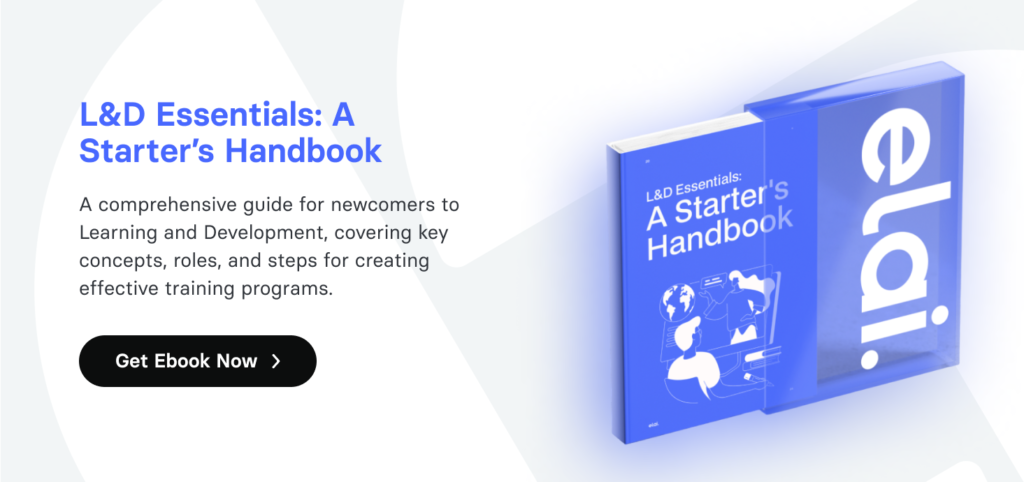In the dynamic realm of Learning and Development, continuous learning is not just a recommendation but a necessity. Practitioners must consistently adapt to evolving methodologies, emerging technologies, and shifting trends to guarantee training initiatives stay impactful and effective.
Curated here is a selective list of L&D books addressing a diverse range of topics important to professionals. From principles of instructional design to innovative technologies and methodologies, these texts offer valuable insights and practical strategies to assist excelling in one’s role and meaningfully impacting one’s organization. Whether searching for guidance designing engaging learning, leveraging technology to back employee development, or nurturing a culture of innovation within an organization, valuable resources within will inform and inspire your journey. Let’s delve into the world of best books for Learning and Development professionals and discover the insights and inspiration awaiting within these pages.
1. Julie Dirksen “Design for How People Learn”
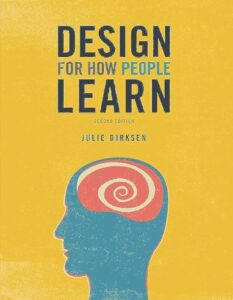
You may find this book in every list of Best Books for L&D professionals for a reason. In “Design For How People Learn,” you’ll explore the core principles of learning, memory, and attention and learn how to apply them to create materials that facilitate both acquisition and retention of knowledge and skills. This book incorporates the latest insights and research on learning and memory, offering new strategies for utilizing social media for learning purposes. Through accessible visual representations, practical methods, and real-world examples, “Design For How People Learn” equips you with the tools to enhance your own learning process and effectively engage your audience.
2. Dr. Keith Keating “The Trusted Learning Advisor: The Tools, Techniques and Skills You Need to Make L&D a Business Priority”
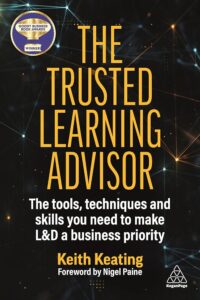
The next from our Learning and Development books, penned by an author boasting over two decades of experience in the industry, elucidates the requisite skills for L&D professionals to transform into strategic consultative partners for businesses. By driving value for organizations and unleashing human potential, L&D professionals can assert their significance. Brimming with practical insights, tools, and guidance, “The Trusted Learning Advisor” encompasses a spectrum of topics, ranging from strategies for honing consultative skills essential for cultivating trust and fostering relationships with stakeholders—the cornerstone of a Trusted Learning Advisor—to assessing an organization’s L&D maturity level.
Additionally, the book provides practical guidance on quantifying the value of learning initiatives and effectively communicating this impact to the organization, along with aligning the learning strategy with the broader business objectives.
This indispensable guide also furnishes support on critical thinking, communication, and influential skills, along with advice on cultivating a growth mindset. Enriched with examples, actionable steps, and global case studies drawn from Fortune 500 companies, this book is indispensable for all L&D practitioners aspiring to evolve into strategic consultative partners that genuinely enhance organizational value and fulfill their ultimate purpose in L&D: transforming lives through learning.
3. Donald Clark “Artificial Intelligence for Learning – How to use AI to Support Employee Development”
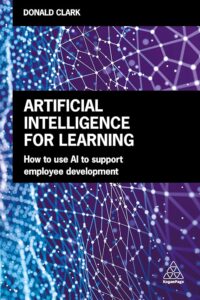
From enhancing learner engagement through content curation and personalization to streamlining evaluation, assessment, and reporting processes, this book provides actionable guidance on leveraging AI to its fullest potential. Moreover, it explores how chatbots can offer invaluable learner support to a globally dispersed workforce.
“Artificial Intelligence for Learning” dispels misconceptions and strips away the hype surrounding AI, empowering L&D professionals to confidently evaluate its utility and make informed investment decisions. It emphasizes AI’s role as a complement to traditional learning methodologies rather than a replacement, highlighting its capacity to augment workplace learning.
effectiveness, mitigate online learning dropout rates, and enhance return on investment (ROI).
Featuring real-world examples from leading companies such as Netflix, British Airways, and the NHS, as well as insightful case studies, this book is essential reading for L&D practitioners keen on unlocking the transformative potential of AI in practice. Whether you’re looking to optimize learning outcomes, boost organizational efficiency, or drive measurable business impact, “Artificial Intelligence for Learning” equips you with the knowledge and tools needed to navigate the AI landscape with confidence and clarity.
4. Sharon Boller & Laura Fletcher “Design Thinking for Training and Development”
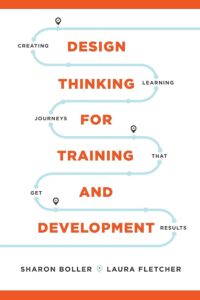
“Diving into Design Thinking for Training and Development,” serves as an essential introduction to design thinking, a methodology centered on human-centric problem-solving. By actively involving users in the design process, this approach ensures solutions are tailored to their needs. For talent development professionals to effectively leverage design thinking, it’s essential to move beyond mere user experience (UX) considerations and embrace the learner experience (LX).
Within this practical guide, Sharon Boller and Laura Fletcher delve into the application of design thinking tools and techniques specifically tailored for training and development projects. Through their adapted process, they outline actionable steps aimed at:
- Get perspective.
- Refine the problem.
- Ideate and prototype.
- Iterate (develop, test, pilot, and refine).
- Implement.
5. Cara North “Learning Experience Design Essentials: Designing for Users and Impact”
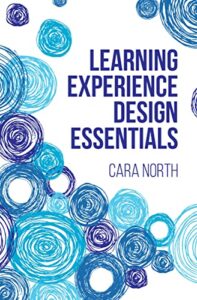
In “Learning Experience Design Essentials,” Cara North delves into the art of blending content and context to create impactful learning experiences, catering to both new instructional designers and those seeking to align their practices with organizational objectives.
North outlines a comprehensive LXD process designed to empower readers in crafting compelling learning experiences. This process encompasses vital elements such as task analysis, enabling an understanding of learners’ workplace contexts. Unlike traditional instructional design paradigms, which often prioritize content dissemination over contextual understanding, “Learning Experience Design Essentials” emphasizes the dynamic nature of learning as a continuous process rather than a singular event.
The book offers a practical roadmap for implementation, allowing readers to develop a structured 30/60/90-day plan for integrating LXD concepts into their practice. By the conclusion, readers will feel equipped to confidently answer the pivotal question: “Would you want to partake in the learning experiences you’ve created?”
6. Megan Torrance “Agile for Instructional Designers: Iterative Project Management to Achieve Results”
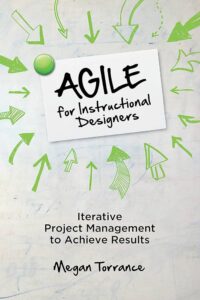
While traditionally popular in the software development realm, Agile principles find new application in instructional design, offering a flexible framework for responding to change and delivering tailored content to learners. “Agile for Instructional Designers”is a must-have for L&D professional development books, where it advocates for the adoption of Agile methodology in managing training projects, highlighting the limitations of traditional linear processes in meeting business and end-user requirements.
Author Megan Torrance recognizes the unique needs and outcomes of instructional design compared to software development. To address this disparity, Torrance introduces the LLAMA™ methodology, which integrates the incremental, iterative approach of Agile projects with the established phases of ADDIE. This methodology enables learners to test and evaluate design elements before finalization and accommodates mid-project adjustments driven by stakeholders, subject matter experts, or organizational leaders.
Featuring templates for goal alignment, learner personas, scope definition, estimating, planning, and iterative development, “Agile for Instructional Designers” equips L&D professionals with the tools necessary to embrace change and navigate the evolving landscape of learning and development effectively.
7. Cathy Moore “Map It: The hands-on guide to strategic training design”
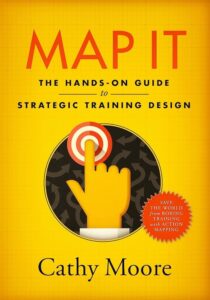
In the next item of our list of books on Learning and Development, you’ll unlock the secrets to helping clients pinpoint the root cause of performance issues, assessing whether training is the most suitable solution, and crafting practical activities that enable learners to hone essential skills rather than merely demonstrating knowledge. You’ll learn to select the optimal format for each activity, seamlessly integrating them into workflows or providing them on-demand.
Empower learners to access vital information without overwhelming them with unnecessary data dumps, create engaging activities that inspire participation and motivation, and demonstrate the concrete improvements your project brings to organizational performance. Through a blend of humor and numerous real-world examples, “Map It” introduces you to action mapping—a visual approach to needs analysis and training design embraced by organizations worldwide for efficient and effective performance enhancement.
8. Peter C. Brown “Make It Stick: The Science of Successful Learning”
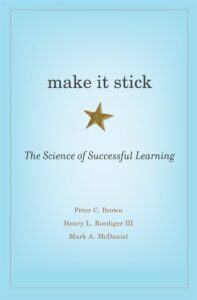
In “Make It Stick: The Science of Successful Learning,” the authors challenge conventional wisdom surrounding teaching and learning methods. Rather than catering to individual learning styles or relying on strategies that make learning feel easier, they draw upon recent findings in cognitive psychology to offer concrete techniques for fostering more effective learning experiences.
Central to the discussion is the role of memory in complex cognitive tasks, such as problem-solving and inference-making. By exploring how memory is encoded, consolidated, and retrieved, the authors shed light on the mechanisms behind successful learning. They argue that grappling with the challenges inherent in learning leads to deeper mastery and better retention of knowledge.
By incorporating insights from these best Learning and Development books into your professional practice, you can keep yourself at the cutting edge of what is going on in L&D, drive innovation within your organization and, ultimately, make a substantial impact on the development and growth of learners. As an aspiring L&D specialist who wants to become better with their instructional design skills, start leaning towards newly developed technologies, and stimulate a culture of active learning within an organization, you will benefit significantly from the lessons shared in L&D books.

